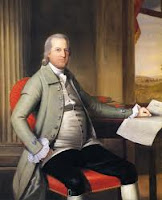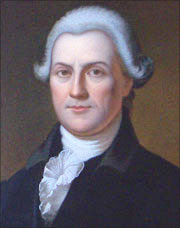 Connecticut four signers of the Declaration of Independence were Samuel Huntington, Roger Sherman, Oliver Wolcott and William Williams. Of the four, Huntington and Sherman were present to adopt the document on the 4th. Wolcott who had become ill, had returned to CT. Williams was in route to replace Wolcott.
Connecticut four signers of the Declaration of Independence were Samuel Huntington, Roger Sherman, Oliver Wolcott and William Williams. Of the four, Huntington and Sherman were present to adopt the document on the 4th. Wolcott who had become ill, had returned to CT. Williams was in route to replace Wolcott.William Williams (Apr. 23, 1731 - Aug. 2, 1811): Born in Lebanon, CT where his father was minister of the Congregationalist Church, Williams followed in his father's footsteps and studied theology at Harvard, graduating in 1751. However, soon afterward, he join the militia to fight in the French and Indian War. This experience soured his opinion of British officers. After the war he opened a store in Lebanon called The Williams, Inc. It was the beginning of his very successful merchant career. He was elected Town Clerk. He held that position for 44 years. He was a Selectman for 25years, served the provincial and later state Legislature for nearly 40 years-during which time he was councilor, member, and Speaker of the House. In 1773 he was made Colonial in the Connecticut Militia. He was elected to the Continental Congress in 1776 to replace the ailing Wolcott. He didn't arrive until July 28 but was present for the formal signing of the document on Aug 2nd. Later he was appointed a member of the committee to frame the Articles of Confederation. In 1777 he was appointed to the Board of War. After the war, he attended the Hartford Convention, where Connecticut ratified the Constitution. Originally sent to vote against its adoption, he decided that Connecticut would benefit from it and he voted for it even though he objected to the clause forbidding religion tests. Williams spent his remaining years as a County Court judge.






